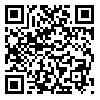Volume 18, Issue 1 (March 2020)
Iranian Rehabilitation Journal 2020, 18(1): 91-98 |
Back to browse issues page
Download citation:
BibTeX | RIS | EndNote | Medlars | ProCite | Reference Manager | RefWorks
Send citation to:



BibTeX | RIS | EndNote | Medlars | ProCite | Reference Manager | RefWorks
Send citation to:
Mokhtarinia H, Rafinia M, Shahbazi A, Khodaie Ardakani M R, Ghaedamini Harouni G R, Gabel C P. The Cross-cultural Adaptation of the Smartphone Addiction Scale to Persian. Iranian Rehabilitation Journal 2020; 18 (1) :91-98
URL: http://irj.uswr.ac.ir/article-1-1035-en.html
URL: http://irj.uswr.ac.ir/article-1-1035-en.html
Hamidreza Mokhtarinia *1 

 , Mahta Rafinia1
, Mahta Rafinia1 

 , Akram Shahbazi1
, Akram Shahbazi1 

 , Mohammad Reza Khodaie Ardakani2
, Mohammad Reza Khodaie Ardakani2 

 , Gholam Reza Ghaedamini Harouni3
, Gholam Reza Ghaedamini Harouni3 

 , Charls Philip Gabel4
, Charls Philip Gabel4 




 , Mahta Rafinia1
, Mahta Rafinia1 

 , Akram Shahbazi1
, Akram Shahbazi1 

 , Mohammad Reza Khodaie Ardakani2
, Mohammad Reza Khodaie Ardakani2 

 , Gholam Reza Ghaedamini Harouni3
, Gholam Reza Ghaedamini Harouni3 

 , Charls Philip Gabel4
, Charls Philip Gabel4 


1- Department of Ergonomics, University of Social Welfare and Rehabilitation Sciences, Tehran, Iran.
2- Psychosis Research Center. University of Social Welfare and Rehabilitation Sciences, Tehran, Iran.
3- Social Welfare Management Research Center, University of Social Welfare and Rehabilitation Sciences, Tehran, Iran.
4- Independent Researcher Coolum Beach, Sunshine Coast, QLD, Australia.
2- Psychosis Research Center. University of Social Welfare and Rehabilitation Sciences, Tehran, Iran.
3- Social Welfare Management Research Center, University of Social Welfare and Rehabilitation Sciences, Tehran, Iran.
4- Independent Researcher Coolum Beach, Sunshine Coast, QLD, Australia.
Abstract: (5793 Views)
Objectives: instruments and methods evaluate addiction to the Internet, mobile, and smartphone use. Subject-reported outcome measures, such as the Smartphone Addiction Scale (SAS) assess such addiction. The objectives of this study were to cross-culturally adapt the SAS into Persian (SAS-Pr) and to evaluate the properties of reliability and validity in the Persian setting.
Methods: The English version of the SAS was translated into Persian according to the published guidelines, using forward-translation, synthesis, back translation, consolidated consensus translations from an expert committee, and in pilot-testing. The pilot trial was performed with recruited medical students (n=50) with an interview used to determine the comprehensibility, readability, understandability, interpretation, and cultural relevance of the questionnaire. A further sample of medical students (n=100) was recruited for test-retest reliability performed at baseline and 7-14 days later, using the intraclass correlation coefficient (ICC2,1) and internal consistency using Cronbach’s α.
Results: The translation of SAS-Pr was achieved with minimum difficulty. During this process, item 15 was revised and in items 24 and 25, the “telegram” phrase was added. The participants found the comprehensibility, readability, understandability, interpretation, and completeness of the questionnaire conclusive. Furthermore, high levels of test-retest reliability (ICC2,1=0.81) and internal consistency (α=0.948) were obtained.
Discussion: The SAS-Pr adaptation was successful and the translated version showed promising positive psychometric properties. The SAS-Pr can be applied in research settings and in identifying Persian-speaking people at risk of addiction to the smartphone.
Methods: The English version of the SAS was translated into Persian according to the published guidelines, using forward-translation, synthesis, back translation, consolidated consensus translations from an expert committee, and in pilot-testing. The pilot trial was performed with recruited medical students (n=50) with an interview used to determine the comprehensibility, readability, understandability, interpretation, and cultural relevance of the questionnaire. A further sample of medical students (n=100) was recruited for test-retest reliability performed at baseline and 7-14 days later, using the intraclass correlation coefficient (ICC2,1) and internal consistency using Cronbach’s α.
Results: The translation of SAS-Pr was achieved with minimum difficulty. During this process, item 15 was revised and in items 24 and 25, the “telegram” phrase was added. The participants found the comprehensibility, readability, understandability, interpretation, and completeness of the questionnaire conclusive. Furthermore, high levels of test-retest reliability (ICC2,1=0.81) and internal consistency (α=0.948) were obtained.
Discussion: The SAS-Pr adaptation was successful and the translated version showed promising positive psychometric properties. The SAS-Pr can be applied in research settings and in identifying Persian-speaking people at risk of addiction to the smartphone.
Article type: Original Research Articles |
Subject:
Ergonomics
Received: 2019/06/19 | Accepted: 2019/10/5 | Published: 2020/03/1
Received: 2019/06/19 | Accepted: 2019/10/5 | Published: 2020/03/1
Send email to the article author





